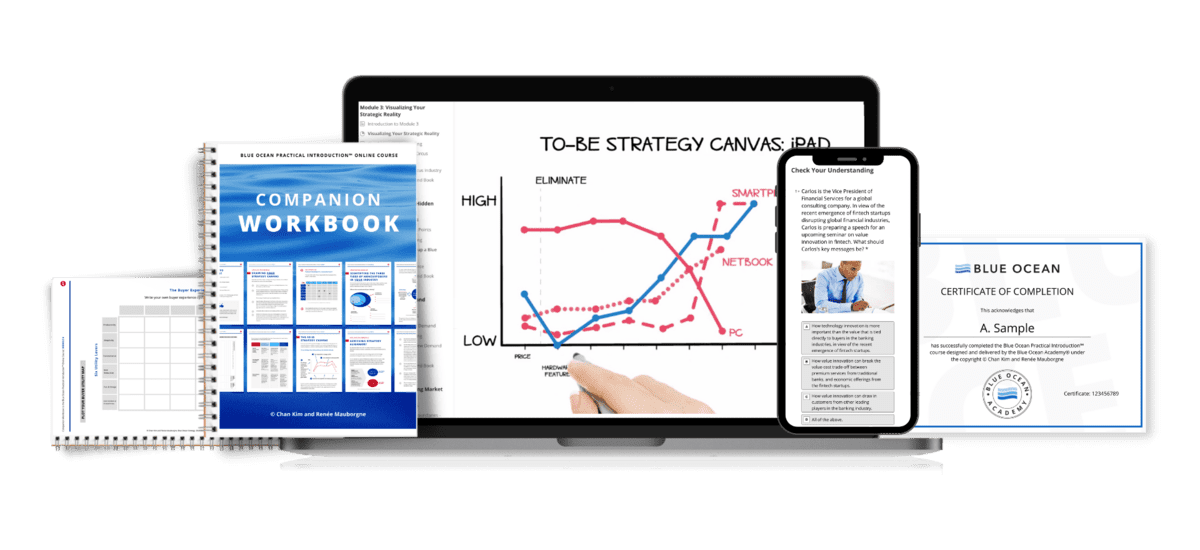THE FORD MODEL T
Ford’s Model T, introduced in 1908, is a classic example of a market-creating blue ocean strategic move that challenged the conventions of the automotive industry in the United States. It made the automobile accessible to the mass of the market.
Until that time, America’s five hundred automakers built custom-made novelty automobiles. Despite the number of automakers, the industry was small and unattractive with cars unreliable and expensive, costing around $1,500, twice the average annual family income. But Ford changed all of that with the Model T.
He called it the car ‘for the great multitude, constructed of the best materials.’ Although it only came in one color (black) and one model, the Model T was reliable, durable, and easy to fix. And it was priced so that the majority of Americans could afford one. In 1908 the first Model T cost $850, half the price of existing automobiles. In 1909 it dropped to $609, by 1924 it was down to $240. A 1909 sales brochure proclaimed, ‘Watch the Ford Go By, High Priced Quality in a Low Priced Car.’
Ford’s success was underpinned by a profitable business model. By keeping the cars highly standardized and offering limited options and interchangeable parts, Ford’s revolutionary assembly line replaced skilled craftsmen with ordinary unskilled laborers who worked one small task faster and more efficiently, cutting the labor hours by 60 percent. With lower costs, Ford was able to charge a price that was accessible to the mass market.
Sales of the Model T exploded. Ford’s market share surged from 9 percent in 1908 to 61 percent in 1921. So great was the blue ocean Ford created that the Model T replaced the horse-drawn carriage as the primary means of transport in the United States.
This automotive industry case study highlights the common pattern underlying successful blue ocean strategic moves: Value Innovation. It’s the simultaneous pursuit of differentiation and low cost that allows companies to unlock new demand and create blue oceans of uncontested market space.
THE FORD MODEL T
Ford’s Model T, introduced in 1908, is a classic example of a market-creating blue ocean strategic move that challenged the conventions of the automotive industry in the United States. It made the automobile accessible to the mass of the market.
Until that time, America’s five hundred automakers built custom-made novelty automobiles. Despite the number of automakers, the industry was small and unattractive with cars unreliable and expensive, costing around $1,500, twice the average annual family income. But Ford changed all of that with the Model T.
He called it the car ‘for the great multitude, constructed of the best materials.’ Although it only came in one color (black) and one model, the Model T was reliable, durable, and easy to fix. And it was priced so that the majority of Americans could afford one. In 1908 the first Model T cost $850, half the price of existing automobiles. In 1909 it dropped to $609, by 1924 it was down to $240. A 1909 sales brochure proclaimed, ‘Watch the Ford Go By, High Priced Quality in a Low Priced Car.’
Ford’s success was underpinned by a profitable business model. By keeping the cars highly standardized and offering limited options and interchangeable parts, Ford’s revolutionary assembly line replaced skilled craftsmen with ordinary unskilled laborers who worked one small task faster and more efficiently, cutting the labor hours by 60 percent. With lower costs, Ford was able to charge a price that was accessible to the mass market.
Sales of the Model T exploded. Ford’s market share surged from 9 percent in 1908 to 61 percent in 1921. So great was the blue ocean Ford created that the Model T replaced the horse-drawn carriage as the primary means of transport in the United States.
This automotive industry case study highlights the common pattern underlying successful blue ocean strategic moves: Value Innovation. It’s the simultaneous pursuit of differentiation and low cost that allows companies to unlock new demand and create blue oceans of uncontested market space.
THE BLUE OCEAN STRATEGY PRACTITIONER PROGRAM

Transform your strategic perspective, master blue ocean tools and frameworks, & learn to unlock new growth opportunities
Get started with new market creation with our live, interactive, expert-led program.


















